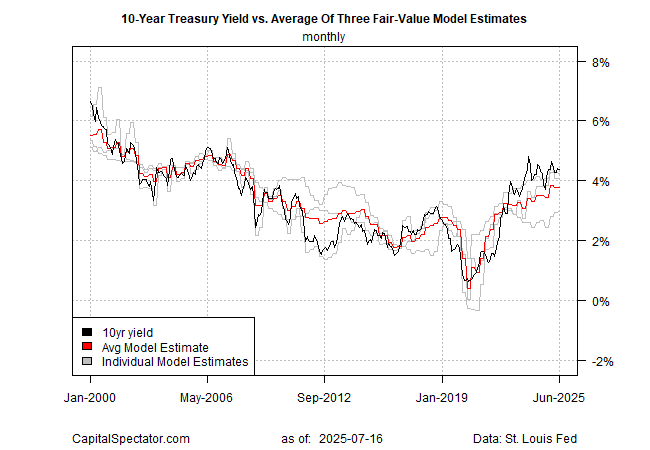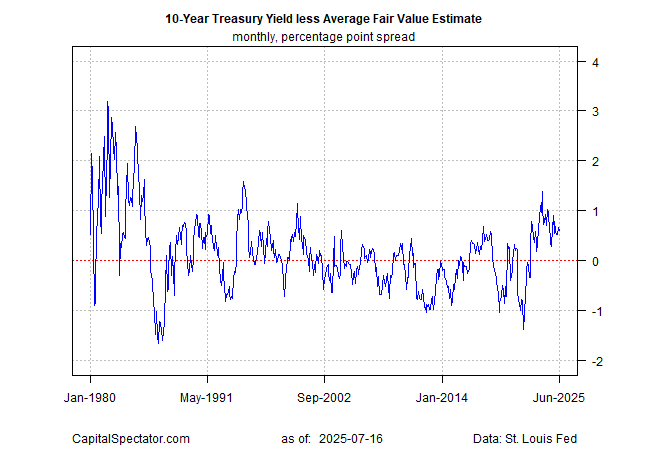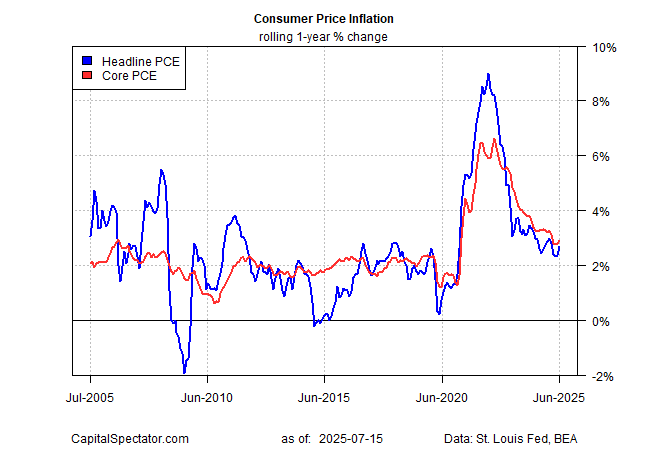Is this U.S.-China selloff a buy? A top Wall Street voice weighs in
The market premium for the US Treasury yield edged lower in June, based on analysis using a “fair value” estimate. But with inflation showing signs of heating up due to tariffs, economic conditions don’t look particularly conducive for an ongoing decline in the market premium for the near term.
The current average monthly fair-value estimate for June via several models is 3.77%, which remains moderately below the actual 10-year yield. In yesterday’s trading, the benchmark rate was 4.50% (July 15), a middling level vs. recent history. Relative to the current average fair value estimate, that equates with a market premium of 73 basis points, a middling premium year to date. The fair value estimate is calculated as the mean based on three models run by Capital Spectator.

Based on monthly data, the market premium in June continued to hold in the 50-100 basis point range, which has prevailed so far in 2025. Investors will be keenly watching how tariffs affect the 10-year yield in the weeks and months ahead. Given an expectation that tariffs will remain elevated, it’s reasonable to speculate that the recent range for the market premium will rise as the crowd demands higher compensation for holding US debt. Another factor that looks set to keep the market premium relative high: estimates that the US federal budget deficit will deepen in the years ahead.

US consumer inflation for June rose more than expected at the headline level. The Consumer Price Index (CPI) increased 2.7% vs. the year-ago level, the fastest pace since February. Core CPI, which strips out the volatile food and energy inputs, ticked up to a 2.9% annual rate.

“Today’s report showed that tariffs are beginning to bite,” said Omair Sharif, head of Inflation Insights, “apparel prices rose, household furnishing prices jumped … and recreation commodities increased.”
“Inflation has started a slow climb as signs of tariff-induced inflation are now evident within durable and nondurable imports,” advised Joe Brusuelas, chief economist at RSM US “That prompts an important question: Will service and housing inflation, which is easing but still elevated, cool further to offset what will be a more pronounced increase in durable and nondurable goods? Our sense is that the Federal Reserve will continue to display patience as the direction of inflation evolves,” he added.
Fed funds futures are currently predicting a near-certain probability that the central bank will leave its target rate unchanged at a 4.25%-4.50% range for the upcoming July 30 FOMC meeting, based on CME data. The estimate for the September meeting, which recently had been leaning toward a moderate probability for a rate cut, is now closer to a coin-flip forecast, according to the future market.
